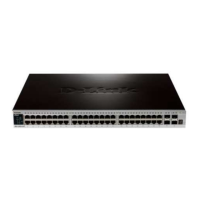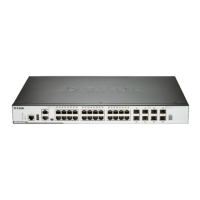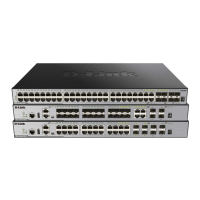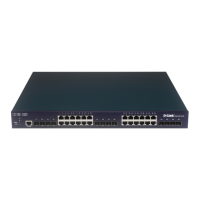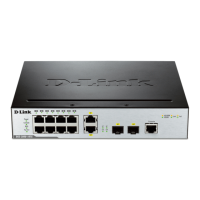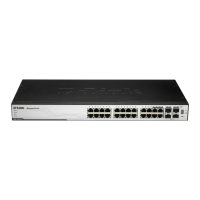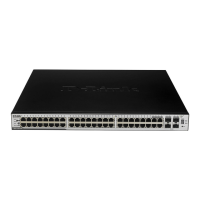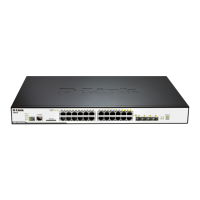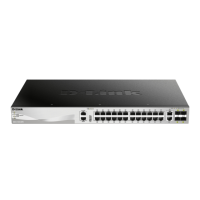Do you have a question about the D-Link DGS-3620-28PC-SI and is the answer not in the manual?
Provides essential safety guidelines for operating the system and protecting against potential damage.
Steps to access the switch's web manager by entering its IP address in a browser.
Details on Power over Ethernet support, including IEEE 802.3af/at and power delivery capabilities.
Manages user privileges and controls access to switch configuration and management.
Information about combining multiple switches into a stack for centralized management.
Manages IP interfaces, including static and dynamic IP address configuration.
Configuration of the switch's IP address, subnet mask, and default gateway.
Concept for stacking switches over Ethernet using a single IP address for simplified management.
Process for upgrading firmware on member switches from a Commander Switch.
Used to upgrade, backup, and restore configuration files using a TFTP server.
Configuration for Simple Network Management Protocol (SNMP) for device management and monitoring.
Overview of Virtual Local Area Networks and their role in network segmentation and performance.
Details tagged VLANs and their implementation across the network for segmentation.
VLANs configured per port, limiting traffic flow and defining port access rights.
Lists and configures existing VLANs by VLAN ID and VLAN Name.
Configuration for Voice VLANs to carry voice traffic from IP phones, prioritizing voice packets.
Configuration to enable VLANs on ports, allowing frames from unknown VLAN groups to pass.
QinQ VLANs allow network providers to expand VLAN configurations for customer VLANs within larger VLANs.
Configuration of QinQ parameters, including state, TPID, and port roles.
Overview of Spanning Tree Protocols (STP, RSTP, MSTP) for loop prevention.
Configuration of global Spanning Tree Protocol bridge parameters.
Per-port configuration for Spanning Tree Protocol settings.
Combines multiple ports into a single high-bandwidth data pipeline.
Configuration of port trunk settings, including algorithm, type, and master port.
Controls multicast traffic at Layer 2, including IGMP and MLD proxy and snooping.
Manages IGMP proxy state and upstream interface for multicast traffic forwarding.
Recognizes IGMP queries and reports to manage multicast traffic efficiently.
Enables IGMP Snooping and allows fine-tuning of settings for each VLAN.
Configures MLD proxy state and upstream interface for IPv6 multicast traffic.
IPv6 function similar to IGMP snooping for IPv4, discovering ports requesting multicast data.
Configuration of MLD snooping settings.
Manages traffic flow by limiting multicast traffic to specific VLANs.
Filters multicast traffic based on various criteria.
Configuration for filtering IPv4 multicast traffic.
Configuration for filtering IPv6 multicast traffic.
Configuration for Ethernet Ring Protection Switching (ERPS) for ring topology protection.
Overview of Link Layer Discovery Protocol for network device discovery.
Configuration for LLDP-MED features, including log state and system information.
Precision Time Protocol (PTP) for synchronizing distributed clocks over Ethernet networks.
Configuration of static routing entries for IPv4 formatted addressing.
Entry of static IPv6 addresses into the switch's routing table.
Creation of policy routes and definition of their rule names.
Creation of static multicast routes for IP multicast packet handling.
Configuration of ECMP OSPF state and ECMP route load-balancing algorithm.
Redistributes routing information from other protocols to RIP, OSPF, or BGP.
Overview of Open Shortest Path First (OSPF) routing protocol.
Configuration and operational details for OSPFv2 protocol.
Configuration of OSPF global settings for the switch.
Configuration of OSPF Area settings, grouping contiguous networks and hosts.
Configuration of OSPF interface settings for the switch.
Configuration and operation details for OSPFv3 protocol.
Configuration of OSPFv3 global settings for the switch.
Configuration of OSPFv3 area settings.
Configuration of OSPFv3 interface settings.
Overview of Routing Information Protocol (RIP) for distance-vector routing.
Configuration of RIP settings for one or more IP interfaces.
Functions supporting IP multicasting: IGMP, DVMRP, PIM-DM/SM/SSM.
Internet Group Management Protocol for communicating multicast group membership.
Configuration of IGMP on a per-IP interface basis.
Multicast Listener Discovery Protocol for IPv6, similar to IGMP for IPv4.
Configuration of MLD interface settings.
Protocol Independent Multicast overview for IP networks.
Configuration and operation of PIM Sparse Mode.
Configuration and operation of PIM Dense Mode.
Configuration settings for PIM protocol in IPv4 networks.
Configuration of PIM global state and parameter settings for distribution trees.
Configuration of PIM protocol settings per IP interface.
Virtual Router Redundancy Protocol for dynamic assignment of virtual router responsibility.
Configuration of VRRP virtual router settings.
Configuration and operation of Border Gateway Protocol (BGP).
Configuration of BGP state, AS number, and global settings.
Configuration of BGP dampening settings to avoid unstable networks caused by flapping routes.
Creation or deletion of Border Gateway Protocol (BGP) neighbors.
Configuration and management of BGP neighbors.
Configuration of IP prefix lists and standard access lists for route filtering.
Creation and configuration of IP prefix lists.
Creation of access lists used to filter routes.
Creation of route maps and addition/deletion of sequences.
Configuration of 802.1p priority queuing for Quality of Service.
Settings to control transmitting and receiving data rates for selected ports.
Configuration to limit data rates on ports, applying ceilings to transmit and receive speeds.
Monitors and controls traffic flow to mitigate issues caused by packet storms.
Configuration of how the switch maps incoming packets to hardware priority queues.
Configuration of packet mapping to priority queues based on 802.1p user priority.
Assists users in creating access profiles and ACL rules by inputting address, service type, and action.
Allows users to establish criteria for packet forwarding based on header information.
Manages egress access profiles for per-flow processing of packets leaving the switch.
Overview of IEEE 802.1X standard for authorizing and authenticating network access.
Details the two types of Access Control used on the Switch: Port-Based and Host-Based.
Controls port authorization state, allowing traffic after successful authentication.
Creates logical ports for each attached device, enabling independent control of EAPOL exchanges.
Configuration of global parameters for the 802.1X function.
Configuration of 802.1X authenticator settings on a per-port basis.
Implementation of 802.1X Guest VLANs for limited access for non-802.1X supported devices.
Overview of RADIUS feature for centralized user administration and network protection.
Configures RADIUS server settings for authentication.
Restricts network access by binding IP-MAC addresses to specific ports.
Functionality to restrict DHCP server packets and manage client IP assignments.
Method to authenticate and authorize access using port or host MAC addresses.
Sets parameters for MAC-based access control, including authentication and port configuration.
Configures a list of MAC addresses with their corresponding target VLAN for switch authentication.
Feature for authenticating users accessing the Internet via the switch using HTTP or HTTPS.
Configures the switch for the Web-based access control function.
Views and sets local database user accounts for Web authentication.
Views and sets port configurations for Web authentication.
Allows multiple authentication methods to be supported on the switch.
Configures Authorization Network State Settings and compound authentication methods.
Prevents unauthorized computers from gaining access to the network using MAC addresses.
Configures port security settings, including locking MAC addresses to ports.
Configures spoofing prevention entry to prevent MAC spoofing for the protected gateway.
Configures BPDU protection function for ports to prevent BPDU handling attacks.
Detects loops created by specific ports and temporarily shuts down the port.
Restricts DHCP Server packets and receives specified DHCP server packets.
Allows users to secure access using TACACS/XTACACS/TACACS+/RADIUS protocols.
Enables administrator-defined authentication policy for users accessing the switch.
Configures user-defined authentication server hosts for TACACS/XTACACS/TACACS+/RADIUS.
Configures user-defined authentication techniques for users logging onto the switch.
Provides secure communication path using SSL for authentication, digital signatures, and encryption.
Secure Shell (SSH) for secure remote login and network services over insecure networks.
Configures and views settings for the SSH server.
Configures SSH algorithms for authentication encryption.
Configures parameters for users attempting to access the switch via SSH.
Configures trusted host secure IP addresses or ranges for remote switch management.
Configures Safeguard Engine to minimize workload during attacks and manage traffic flow.
Overview of Dynamic Host Configuration Protocol for IP parameter assignment.
Configuration of DHCP Relay settings.
Configures DHCPv6 relay state and destination IPv6 addresses.
Overview of Domain Name System (DNS) for mapping names to IP addresses.
Simple Network Time Protocol for synchronizing computer clocks via the Internet.
Configures time settings for the switch, including server IP and poll interval.
Configuration for Connectivity Fault Management (CFM) parameters.
Configures CFM parameters including state, MD, Level, and SenderID TLV.
Configures CFM loopback settings for ports.
Configures CFM linktrace settings for path tracing.
Overview of Ethernet Operations, Administration, and Maintenance (OAM).
Configures Ethernet OAM settings.
Configures Ethernet OAM configuration parameters.
Tests copper cables to determine quality and identify errors.
Monitors resource utilization, including CPU, DRAM, Flash, and Port utilization.
Displays the percentage of CPU usage over time intervals.
Displays the percentage of total available bandwidth used on each port.
Allows viewing packet statistics (RX/TX, Bytes, Packets, Unicast, Multicast, Broadcast) as graphs or tables.
Detailed statistics for received and transmitted packets.
Displays received packet error statistics.
Allows users to backup the switch configuration and log files.
Downloads firmware to the switch from TFTP, RCP, or HTTP servers.
Uploads firmware from the switch to a TFTP, RCP, or HTTP server.
Downloads configuration files for the switch from TFTP, RCP, or HTTP servers.
Uploads configuration files from the switch to a TFTP, RCP, or HTTP server.
Resets the switch to factory defaults with options to retain specific configurations.
Restarts the switch, with options to save current configuration before rebooting.
Utilizes Packet Content ACL to mitigate DoS attacks caused by ARP spoofing.
Provides essential safety guidelines for operating the system and protecting against potential damage.
Steps to access the switch's web manager by entering its IP address in a browser.
Details on Power over Ethernet support, including IEEE 802.3af/at and power delivery capabilities.
Manages user privileges and controls access to switch configuration and management.
Information about combining multiple switches into a stack for centralized management.
Manages IP interfaces, including static and dynamic IP address configuration.
Configuration of the switch's IP address, subnet mask, and default gateway.
Concept for stacking switches over Ethernet using a single IP address for simplified management.
Process for upgrading firmware on member switches from a Commander Switch.
Used to upgrade, backup, and restore configuration files using a TFTP server.
Configuration for Simple Network Management Protocol (SNMP) for device management and monitoring.
Overview of Virtual Local Area Networks and their role in network segmentation and performance.
Details tagged VLANs and their implementation across the network for segmentation.
VLANs configured per port, limiting traffic flow and defining port access rights.
Lists and configures existing VLANs by VLAN ID and VLAN Name.
Configuration for Voice VLANs to carry voice traffic from IP phones, prioritizing voice packets.
Configuration to enable VLANs on ports, allowing frames from unknown VLAN groups to pass.
QinQ VLANs allow network providers to expand VLAN configurations for customer VLANs within larger VLANs.
Configuration of QinQ parameters, including state, TPID, and port roles.
Overview of Spanning Tree Protocols (STP, RSTP, MSTP) for loop prevention.
Configuration of global Spanning Tree Protocol bridge parameters.
Per-port configuration for Spanning Tree Protocol settings.
Combines multiple ports into a single high-bandwidth data pipeline.
Configuration of port trunk settings, including algorithm, type, and master port.
Controls multicast traffic at Layer 2, including IGMP and MLD proxy and snooping.
Manages IGMP proxy state and upstream interface for multicast traffic forwarding.
Recognizes IGMP queries and reports to manage multicast traffic efficiently.
Enables IGMP Snooping and allows fine-tuning of settings for each VLAN.
Configures MLD proxy state and upstream interface for IPv6 multicast traffic.
IPv6 function similar to IGMP snooping for IPv4, discovering ports requesting multicast data.
Configuration of MLD snooping settings.
Manages traffic flow by limiting multicast traffic to specific VLANs.
Filters multicast traffic based on various criteria.
Configuration for filtering IPv4 multicast traffic.
Configuration for filtering IPv6 multicast traffic.
Configuration for Ethernet Ring Protection Switching (ERPS) for ring topology protection.
Overview of Link Layer Discovery Protocol for network device discovery.
Configuration for LLDP-MED features, including log state and system information.
Precision Time Protocol (PTP) for synchronizing distributed clocks over Ethernet networks.
Configuration of static routing entries for IPv4 formatted addressing.
Entry of static IPv6 addresses into the switch's routing table.
Creation of policy routes and definition of their rule names.
Creation of static multicast routes for IP multicast packet handling.
Configuration of ECMP OSPF state and ECMP route load-balancing algorithm.
Redistributes routing information from other protocols to RIP, OSPF, or BGP.
Overview of Open Shortest Path First (OSPF) routing protocol.
Configuration and operational details for OSPFv2 protocol.
Configuration of OSPF global settings for the switch.
Configuration of OSPF Area settings, grouping contiguous networks and hosts.
Configuration of OSPF interface settings for the switch.
Configuration and operation details for OSPFv3 protocol.
Configuration of OSPFv3 global settings for the switch.
Configuration of OSPFv3 area settings.
Configuration of OSPFv3 interface settings.
Overview of Routing Information Protocol (RIP) for distance-vector routing.
Configuration of RIP settings for one or more IP interfaces.
Functions supporting IP multicasting: IGMP, DVMRP, PIM-DM/SM/SSM.
Internet Group Management Protocol for communicating multicast group membership.
Configuration of IGMP on a per-IP interface basis.
Multicast Listener Discovery Protocol for IPv6, similar to IGMP for IPv4.
Configuration of MLD interface settings.
Protocol Independent Multicast overview for IP networks.
Configuration and operation of PIM Sparse Mode.
Configuration and operation of PIM Dense Mode.
Configuration settings for PIM protocol in IPv4 networks.
Configuration of PIM global state and parameter settings for distribution trees.
Configuration of PIM protocol settings per IP interface.
Virtual Router Redundancy Protocol for dynamic assignment of virtual router responsibility.
Configuration of VRRP virtual router settings.
Configuration and operation of Border Gateway Protocol (BGP).
Configuration of BGP state, AS number, and global settings.
Configuration of BGP dampening settings to avoid unstable networks caused by flapping routes.
Creation or deletion of Border Gateway Protocol (BGP) neighbors.
Configuration and management of BGP neighbors.
Configuration of IP prefix lists and standard access lists for route filtering.
Creation and configuration of IP prefix lists.
Creation of access lists used to filter routes.
Creation of route maps and addition/deletion of sequences.
Configuration of 802.1p priority queuing for Quality of Service.
Settings to control transmitting and receiving data rates for selected ports.
Configuration to limit data rates on ports, applying ceilings to transmit and receive speeds.
Monitors and controls traffic flow to mitigate issues caused by packet storms.
Configuration of how the switch maps incoming packets to hardware priority queues.
Configuration of packet mapping to priority queues based on 802.1p user priority.
Assists users in creating access profiles and ACL rules by inputting address, service type, and action.
Allows users to establish criteria for packet forwarding based on header information.
Manages egress access profiles for per-flow processing of packets leaving the switch.
Overview of IEEE 802.1X standard for authorizing and authenticating network access.
Details the two types of Access Control used on the Switch: Port-Based and Host-Based.
Controls port authorization state, allowing traffic after successful authentication.
Creates logical ports for each attached device, enabling independent control of EAPOL exchanges.
Configuration of global parameters for the 802.1X function.
Configuration of 802.1X authenticator settings on a per-port basis.
Implementation of 802.1X Guest VLANs for limited access for non-802.1X supported devices.
Overview of RADIUS feature for centralized user administration and network protection.
Configures RADIUS server settings for authentication.
Restricts network access by binding IP-MAC addresses to specific ports.
Functionality to restrict DHCP server packets and manage client IP assignments.
Method to authenticate and authorize access using port or host MAC addresses.
Sets parameters for MAC-based access control, including authentication and port configuration.
Configures a list of MAC addresses with their corresponding target VLAN for switch authentication.
Feature for authenticating users accessing the Internet via the switch using HTTP or HTTPS.
Configures the switch for the Web-based access control function.
Views and sets local database user accounts for Web authentication.
Views and sets port configurations for Web authentication.
Allows multiple authentication methods to be supported on the switch.
Configures Authorization Network State Settings and compound authentication methods.
Prevents unauthorized computers from gaining access to the network using MAC addresses.
Configures port security settings, including locking MAC addresses to ports.
Configures spoofing prevention entry to prevent MAC spoofing for the protected gateway.
Configures BPDU protection function for ports to prevent BPDU handling attacks.
Detects loops created by specific ports and temporarily shuts down the port.
Restricts DHCP Server packets and receives specified DHCP server packets.
Allows users to secure access using TACACS/XTACACS/TACACS+/RADIUS protocols.
Enables administrator-defined authentication policy for users accessing the switch.
Configures user-defined authentication server hosts for TACACS/XTACACS/TACACS+/RADIUS.
Configures user-defined authentication techniques for users logging onto the switch.
Provides secure communication path using SSL for authentication, digital signatures, and encryption.
Secure Shell (SSH) for secure remote login and network services over insecure networks.
Configures and views settings for the SSH server.
Configures SSH algorithms for authentication encryption.
Configures parameters for users attempting to access the switch via SSH.
Configures trusted host secure IP addresses or ranges for remote switch management.
Configures Safeguard Engine to minimize workload during attacks and manage traffic flow.
Overview of Dynamic Host Configuration Protocol for IP parameter assignment.
Configuration of DHCP Relay settings.
Configures DHCPv6 relay state and destination IPv6 addresses.
Overview of Domain Name System (DNS) for mapping names to IP addresses.
Simple Network Time Protocol for synchronizing computer clocks via the Internet.
Configures time settings for the switch, including server IP and poll interval.
Configuration for Connectivity Fault Management (CFM) parameters.
Configures CFM parameters including state, MD, Level, and SenderID TLV.
Configures CFM loopback settings for ports.
Configures CFM linktrace settings for path tracing.
Overview of Ethernet Operations, Administration, and Maintenance (OAM).
Configures Ethernet OAM settings.
Configures Ethernet OAM configuration parameters.
Tests copper cables to determine quality and identify errors.
Monitors resource utilization, including CPU, DRAM, Flash, and Port utilization.
Displays the percentage of CPU usage over time intervals.
Displays the percentage of total available bandwidth used on each port.
Allows viewing packet statistics (RX/TX, Bytes, Packets, Unicast, Multicast, Broadcast) as graphs or tables.
Detailed statistics for received and transmitted packets.
Displays received packet error statistics.
Allows users to backup the switch configuration and log files.
Downloads firmware to the switch from TFTP, RCP, or HTTP servers.
Uploads firmware from the switch to a TFTP, RCP, or HTTP server.
Downloads configuration files for the switch from TFTP, RCP, or HTTP servers.
Uploads configuration files from the switch to a TFTP, RCP, or HTTP server.
Resets the switch to factory defaults with options to retain specific configurations.
Restarts the switch, with options to save current configuration before rebooting.
Utilizes Packet Content ACL to mitigate DoS attacks caused by ARP spoofing.
| Device Type | Switch |
|---|---|
| Model | DGS-3620-28PC-SI |
| Switching Capacity | 128 Gbps |
| MAC Address Table Size | 16K |
| PoE Budget | 370W |
| Power over Ethernet (PoE) | Yes |
| Humidity | 5% to 95% non-condensing |
| Rack Mountable | Yes |
| Power Supply | Internal |
| Primary Ports | 24 x 10/100/1000BASE-T |
| Uplink Ports | 4 x 10G SFP+ Ports |
| Jumbo Frame Support | 9K |
| Layer | Layer 3 |
| Dimensions (W x D x H) | 440 x 44 x 250 mm |
| Operating Temperature | 0 to 50°C |
| Storage Temperature | -40 to 70°C |
| Power Consumption | 37W (without PoE) |
| Input Voltage | 100 to 240 VAC |
| Management Type | Web, CLI, SNMP |
